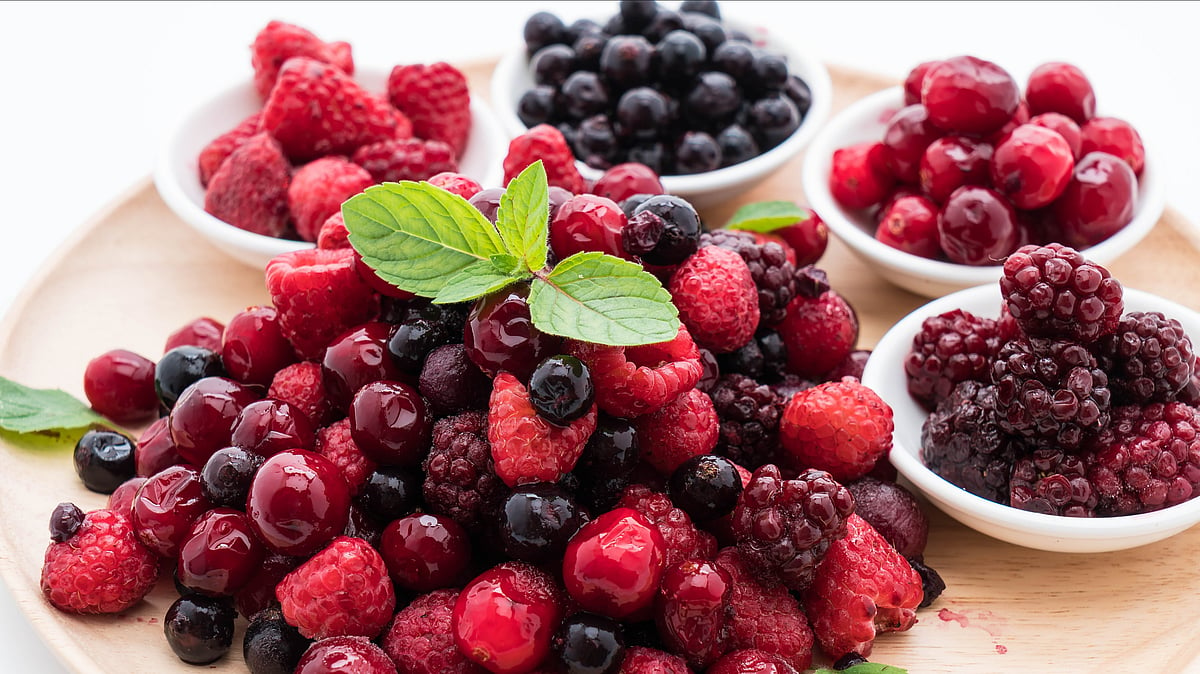As the days get hotter, the fruit get sweeter. Summer means not just juicy mangoes but also the dark, delicious jamun, as well as an assortment of other sweet, tart and yummy berries, which are both enjoyable and beneficial.
Jamun
The best known and probably most visible of the summer berries, jamun has the unpronounceable botanical name Syzygium cumini – but if anyone asks, the more popular English name is the Java plum or Malabar plum.

Part of the fun of eating jamun is getting your tongue to turn purple, but it’s also a good antioxidant and is cooling – particularly needed to counter mangoes which can have a heaty effect on the body.
Jamun is well known to be useful for diabetes patients, as it has the alkaloid jambosine and the glycoside jambolin, which decrease the absorption of sugar into the blood. It is also rich in potassium, and can help control hypertension and atherosclerosis. It is good for digestion, and its detoxifying properties can combat anaemia.
Phalsa
Those who have experienced summer in north India would be familiar with the call of the phalsa seller, “Thande meethe phalse, sharbat wale.” Along with other cooling sharbats and juices, phalsa (Grewia asiatica) is an essential weapon in the war against summer heat. It can be eaten fresh with salt or black salt to counter its sour taste, or it can be made into sharbat, the most popular way of consuming it. It is also good in chutneys and jams.

Phalsa is rich in minerals such as calcium, iron and potassium. It improves dental and bone health, promotes muscle functioning, prevents anaemia and maintains normal fluid balance and nerve transmission. Antioxidants such as anthocyanins and flavonoids help lower the risk of disease, and its anti-inflammatory properties can help with joint pain. Certain tribes are known to use the fruit to treat rheumatism.
Karonda
Also known as karvanda, Carissa carandas is another summer superfood. It’s tasty in both raw and ripe forms – the first in pickles and the second to eat fresh or make into jam. Like most dark-coloured foods, karonda is an anti-inflammatory and antioxidant, and has cooling properties.

It also alleviates abdominal pain and bloating and improves digestion due to its pectin content. It can even help improve mental health as it has magnesium and tryptophan which help stimulate the production of the neurotransmitter serotonin, which works towards bettering overall mental well-being.
Mulberry
Mulberries come in white, red and black varieties, and it’s the last-mentioned one, Morus nigra, which is most common in India. In the North you will see it growing wild by the roadside too.

A good source of magnesium, potassium and phosphorus, mulberries are rich in vitamin C, which helps fight infection and can help stave off certain cancers. The flavonoids in mulberries also fight free radicals to limit oxidative stress.
Mulberries are also rich in phenolic acids, which can play a role in everything from cancer prevention to diabetes management. Moreover, research has suggested that mulberry consumption can reduce cholesterol in the body, lowering the risk of heart-related ailments.
Amla
You will find two types of Phyllanthus emblica or amla – the sour, which is shaped like a miniature pumpkin, and the bitter variety, which is round. Both are light green and both are good for you, but the bitter kind is the one ayurveda loves because of its myriad medicinal properties. You can snack on the sour amla with some black salt to offset the sharp taste, and indeed it is rich in vitamin C. It’s among the range of berries that street vendors sell, with black salt or tangy masala to go with it.

When it comes to the bitter amla, you may be most familiar with the ubiquitous amla supari, available widely in small snack-size packets, which is basically bitter amla pieces dried with black salt. Chew on one and then drink water – you will marvel at the uniquely sweet taste of the water.
Amla is also made into pickles and murabba, and the juice is the one which is widely prescribed in ayurvedic medicine. It is rich in vitamins C and A, as well as flavonoids which boost immunity and memory. Go easy on consumption of the juice, though, as it could cause acidity due to the high vitamin C content, and dehydration as it is laxative; plus, it lowers blood sugar levels. Avoid amla juice if you have kidney problems or are taking blood thinners or diabetes drugs.
Jamun Ice Pops Recipe
Ingredients:
Ripe jamun (de-seeded), 300 gms
Sugar, half a cup
Lime juice, 1 tsp
Black salt, half a tsp
Jeera powder, a pinch
Method: Blend the jamun in a mixer and extract the juice. Add the sugar, lime juice, salt and jeera powder, and stir until fully dissolved. Pour into popsicle moulds and freeze for 8 hours or overnight.
